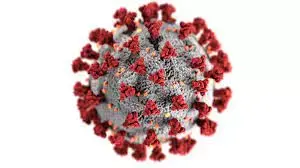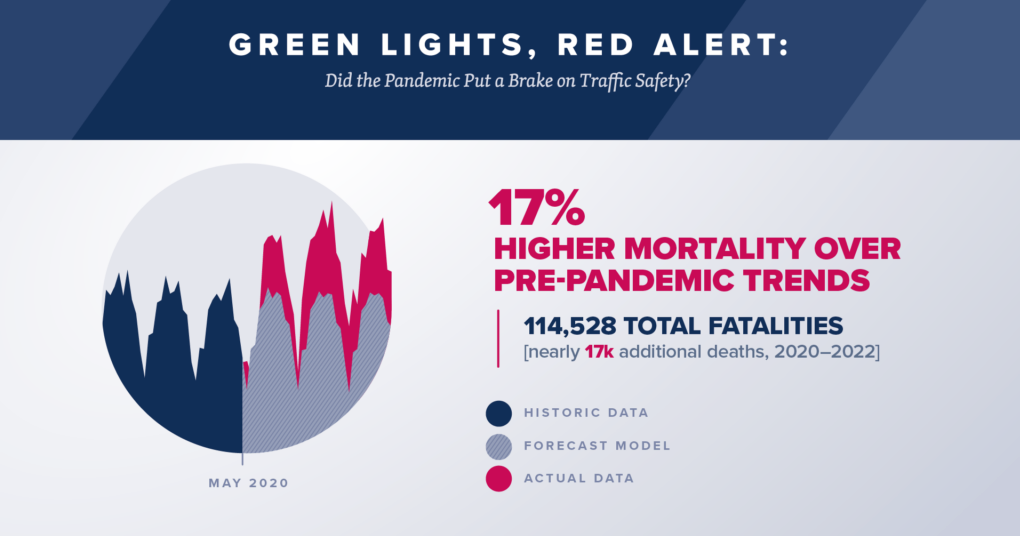article text
Residents in Cottage Grove, Lane County, and across Oregon are learning that that even though the COVID-19 pandemic has subsided, it has left a lasting deadly impact on traffic safety locally and across the nation.
A new study by the AAA Foundation for Traffic Safety (AAAFTS) finds dangerous behaviors such as speeding, not using seatbelts, and impaired driving contributed to a significant rise in fatal crashes compared to the years before the pandemic.
AAAFTS researchers found that 114,528 people were killed in traffic crashes on U.S. roads from May 2020 through December 2022, a 17% jump in traffic deaths (nearly 17,000 additional fatalities) compared to what would have been expected under pre-pandemic trends:
Traffic deaths outpaced forecasts the most for young adults (20-24), with teens (16-19) taking the top spot in 2021.
Men consistently exceeded estimates by 14% to 19%, while women only did so in 2021 (15% increase).
Black Americans, who comprise approximately 12% of the U.S. population, accounted for approximately 34% of the entire rise in traffic fatalities relative to how many would have been expected based on the pre-pandemic trend.
Hispanic Americans, 19% of the U.S. population, accounted for approximately 25% of the increase.
Adults 25 years and older with no education beyond high school exceeded estimates by 12% to 16%
Notably, the new research highlights a disparity in the pandemic’s impact on traffic safety. Black and Hispanic Americans, already disproportionately affected by traffic fatalities, saw even more significant increases from 2020 through 2022. Similarly, those with less education experienced a much sharper rise in fatalities compared to college graduates.
“Our study points to an ongoing disturbing trend of risky driving behaviors, which we noted in previous research earlier in the pandemic,” AAA Foundation President and Executive Director Dr. David Yang said. “There are still far too many road users who lose their lives in preventable crashes. The findings from this latest AAA Foundation study underscore the importance of addressing traffic safety from an equity perspective – communities across the United States must provide safe transportation options to meet the needs of their users.”
Here are key findings in the study:
Risky driving spiked: Speeding and driving under the influence of alcohol remain significant contributors to fatal crashes.
Lack of seatbelt use: The increase in occupant deaths was almost entirely among those not wearing seatbelts.
Fatal crashes across age groups: Drivers and victims of all ages up to 55 saw a significant rise in fatal crash involvement, with men disproportionately affected.
Late-night danger zone: Contrary to initial assumptions, the increase in fatal crashes wasn’t limited to times when the pandemic cleared previously congested daytime roads. Late nights and early mornings saw the most significant spikes.
Unequal impact: The pandemic exacerbated existing disparities in traffic safety. Socially and economically disadvantaged counties and racial and ethnic minorities were disproportionately impacted.
According to the AAA, the research underscores the need for:
Equitable transportation solutions: Providing safe transportation options for vulnerable populations benefits everyone.
Holistic safety approaches: Addressing broader traffic safety issues beyond just the pandemic’s effects.
Safe System framework offers a comprehensive strategy to improve overall road safety.
“Our AAA Foundation research shows that the COVID-19 pandemic has had a lasting negative impact on traffic safety in the U.S., with impaired driving, speeding, and not wearing a seat belt all contributing to a surge in crash fatalities. These behaviors continue long after the pandemic ended,” AAA Oregon/Idaho Public Affairs Director Marie Dodds said. “We have a lot of work to do to provide equitable access to safe transportation for all if we truly have the goal of reducing fatal crashes.”
Research methodology
The research reported here seeks to understand how traffic safety on U.S. roads has changed since the onset of the pandemic by comparing the number and characteristics of traffic fatalities during this period to what would have been expected if the pandemic had not occurred and pre-pandemic trends continued.
Data from the fatal crashes in the decade before the pandemic were used to develop statistical models that were then used to predict how many fatal crashes would have been expected during the pandemic period, without the pandemic.
About the AAA Foundation for Traffic Safety
Established in 1947 by AAA, the Foundation for Traffic Safety is a nonprofit, publicly funded 501©(3) charitable research and educational organization.
The AAA Foundation’s mission is to prevent traffic deaths and injuries by researching their causes and by educating the public about strategies to prevent crashes and reduce injuries when they do occur.
This research informs the development of educational materials for drivers, pedestrians, bicyclists, and other road users.
I have definitely felt that people are worse drivers after COVID than they were before from a totally anecdotal standpoint, but it’s interesting [scary] to see data support it. I wonder if we’re going to have it pegged to the disease itself impacting impulse control or decision-making, or if it is just the effects of watching the fabric of society completely give out and the institutions responsible for social reproduction loudly proclaim that they will do nothing positive ever again for the people they are nominally intended to serve.
the effects of watching the fabric of society completely give out
Exactly, why bother being a polite and considerate driver when it became clear that it is quite literally everyone for themselves
I have definitely felt that people are worse drivers after COVID than they were before
I’ve heard this a lot on Twitter as well.
I wonder if we’re going to have it pegged to the disease itself impacting impulse control or decision-making
I suspect it’s this one. I’m ADHD, which comes with impulse control and decision-making deficits to begin with. I’m pretty cognizant of my baseline executive functioning like that bc I need to be, and basically all of my executive functioning skills got drastically worse for months after I got COVID. I’ve looked into it a bit and there’s a lot of preliminary reports of other ADHDers finding that COVID exacerbates executive functioning difficulties.
FWIW in my case, I feel like I’ve been slowly regaining my pre-infection faculties, but it took 4-6 months to start feeling like there were improvements, and if you’re getting infected that frequently then you’re SOL.
related: “ Traffic Enforcement Dwindled in the Pandemic. In Many Places, It Hasn’t Come Back”
This is just my immediate vibes, but I’m thinking that traffic enforcement is one of the few ok things that cops do, as preventing speeding saves lives. Not that US cops do it well or fairly.
I wonder if this is “blue flu”. Cops in many areas intentionally decreased active law enforcement as a hissy fit in response to defund rhetoric in 2020. I know in my area they basically stopped doing traffic enforcement and people definitely have noticed.
I guess I’m glad if less people are being hassled over bullshit traffic stops, but I’m guessing they haven’t actually stopped doing pretexual stops to search for drugs/warrants. Just abandoning one of the few useful things police departments do.
Everyone has brain damage.

It still blows my mind that so few people care about this. It’s not hard to quantify, either. Researchers can clearly see the damage it’s doing to brain cells.
I’m sure it’ll be fine. Iirc, the brain is a superfluous organ like the appendix.
Instinctually I would peg this on the economic impacts of covid, whether through the decline in traffic enforcement when PD’s threw their fits, lowered trust in society causing the “social glue” to unravel as material conditions worsen, etc.
Socially and economically disadvantaged counties and racial and ethnic minorities were disproportionately impacted.
This seems more like an economic impact than a covid caused brain damage impact.
Socially and economically disadvantaged counties and racial and ethnic minorities were disproportionately impacted.
Except the same can be said about Covid. They were/are getting hit by Covid at a disproportionate rate. They have less access to antivirals, more likely to get infected at work, less access to healthcare in general…
AAAFTS researchers found that 114,528 people were killed in traffic crashes on U.S. roads from May 2020 through December 2022, a 17% jump in traffic deaths (nearly 17,000 additional fatalities) compared to what would have been expected under pre-pandemic trends
That’s roughly 127 deaths a day. Add in the number of people seriously injured per day and I don’t see how driving in the US could be considered safe. Ever wider roads, ever bigger trucks, less traffic enforecement…our state and federal governments are failing us hard on this issue.
The end game of US roads is driving an M4 sherman to work
Correlation != causation. I’d be interested if this trend is the case globally, but otherwise a 17% jump could be attributable to any number of non-covid factors.
You’re right, but there’s been heaps of other research showing that COVID causes neurological problems.
The study: http://aaafoundation.org/wp-content/uploads/2024/07/202407-AAAFTS-Impact-of-COVID.pdf
AAA article about it, the only place I found that links to the study: https://newsroom.aaa.com/2024/08/the-pandemics-tenacious-grip-on-traffic-safety/
had COVID back during the first wave
am aware that I drive faster than I used to
uh… shit, is this article about me?
As a much older person who used to speed in my twenties and thirties, I’ll say the risk to your health and others isn’t worth it. But who am I to judge.
Can’t view the page.
Thanks, Ursula!

Unironically grateful for the gdrp, one of the few good things the eu has done.
You can see the article text that I posted in the spoiler tag, right?










